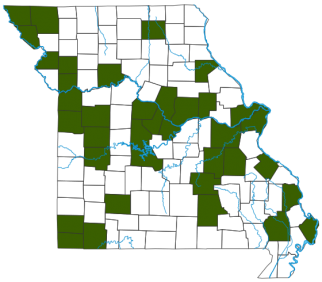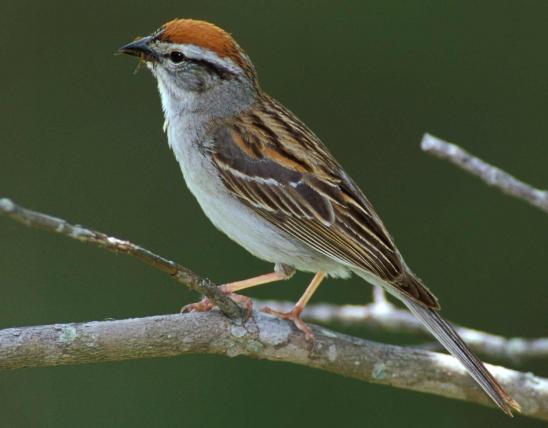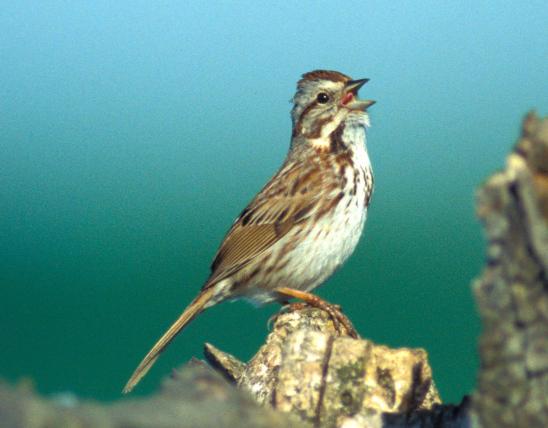
Adult upperparts are reddish brown and streaked with black and tan. There are two bold, white wing bars. The head is gray with a reddish-brown crown, line off the rear edge of the eye, and shoulder crescent. The bill is bicolored: dark on top and yellow below. Underparts are clear gray with a dark spot in the center of the breast (like a "stickpin"). There is a rusty wash on the flanks. The legs are black. The song begins with several clear whistles followed by a rapid warble. The call is a high, tinkling, 3-syllable phrase: tzeedle-eet, most frequently heard in winter in Missouri.
Similar species: Chipping sparrows look similar, but they are here during summers; they're usually not present in Missouri in winter, when American tree sparrows are. "Chippies" have a blackish eyeline, while American tree sparrows have a rufous eyeline. Song sparrows are here in winter, the same time as American tree sparrows, but their breasts are heavily streaked, while the tree sparrows' are clear, sometimes with a single black spot. Field sparrows have a conspicuous white eyering and pink bill. Lark sparrows have a distinctive, ornate head pattern, with rusty, not gray, cheeks. The Eurasian tree sparrow is similar in name; it has a brown cap, a black spot in the center of white cheeks, and is locally common in St. Louis and other parts of northeast Missouri.
Length: 6¼ inches (tip of bill to tip of tail).

During the winter, tree sparrows can be found throughout Missouri, although they are less common in the far southern counties.
Habitat and Conservation
Weedy fields, brushy woodland edges, crop fields, and overgrown gardens. Also commonly seen below platform feeders or other areas where seed has been spread on the ground. Usually only present in Missouri during wintertime. The common name is misleading: American tree sparrows spend most of their time on the ground, usually in brushy or scrubby, but not forested, areas.
Food
Forages in fields and forest edges for insects and seeds, especially weed and grass seeds; also frequents bird feeders, where it looks for seeds on the ground. Tree sparrows often travel in small flocks that may defend a winter-feeding territory. Like many other birds, the winter diet includes a large percentage of plant material, and the summer diet shifts to a larger percentage of insects, providing increased protein for their growing chicks.
Status
Common winter resident. In summer, American tree sparrows nest in willow thickets and arctic shrub along the tundra's edge in Canada and Alaska. But during the winter, tree sparrows can be found throughout Missouri, especially in our northern and western sections. Winter populations can fluctuate from year to year. Although it was long classified in genus Spizella, along with chipping, field, and some other sparrows, DNA evidence recently convinced biologists to put the American tree sparrow into its own genus, Spizelloides.
Life Cycle
American tree sparrows' winter territory includes most of the continental United States, except for our southernmost states. They are present in Missouri from late October through late April, with most departing by the end of February. They breed in northern Canada and Alaska, where the forests reach their northern limit and open tundra begins. They nest on the ground or in low shrubs.
Human Connections
American settlers from Europe bestowed the common name of this bird because it looked a little like the Eurasian tree sparrows they were familiar with. Several American plants and animals were named after European "originals." The American robin, for example, was named after the European robin, which also has a rusty breast.
Ecosystem Connections
Migratory birds play important roles in all the places they live and travel through. The American tree sparrow's insectivorous diet in summers helps limit insect populations in northern Canada; their diet of seeds in their winter range helps limit the spread of weeds and other plants in that territory.



About 350 species of birds are likely to be seen in Missouri, though nearly 400 have been recorded within our borders. Most people know a bird when they see one — it has feathers, wings, and a bill. Birds are warm-blooded, and most species can fly. Many migrate hundreds or thousands of miles. Birds lay hard-shelled eggs (often in a nest), and the parents care for the young. Many communicate with songs and calls.


























